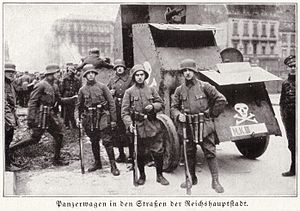
Back Freikorps Afrikaans الفيالق الحرة Arabic Fraykor Azerbaijani Фрайкор Byelorussian Фрайкорпс Bulgarian Freikorps Breton Frikorps Danish Freikorps German Φράικορπς Greek Freikorps Spanish
It has been suggested that this article be split into articles titled Freikorps and Free corps. (discuss) (October 2022) |

Freikorps (German: [ˈfʁaɪˌkoːɐ̯], "Free Corps" or "Volunteer Corps"[1]) were irregular German and other European paramilitary volunteer units that existed from the 18th to the early 20th centuries. They effectively fought as mercenaries or private military companies, regardless of their own nationality. In German-speaking countries, the first so-called Freikorps ("free regiments", Freie Regimenter) were formed in the 18th century from native volunteers, enemy renegades, and deserters. These sometimes exotically equipped units served as infantry and cavalry (or, more rarely, as artillery); sometimes in just company strength and sometimes in formations of up to several thousand strong. There were also various mixed formations or legions. The Prussian von Kleist Freikorps included infantry, jäger, dragoons and hussars. The French Volontaires de Saxe combined uhlans and dragoons.

In the aftermath of World War I and during the German Revolution of 1918–19, Freikorps, consisting partially of World War I veterans, were raised as paramilitary militias. They were ostensibly mustered to fight on behalf of the government[2] against the German communists attempting to overthrow the Weimar Republic.[3][4] However, many Freikorps also largely despised the Republic and were involved in assassinations of its supporters, later aiding the Nazis in their rise to power.[5][6][7]
- ^ Wichmann's German Dictionary, or Pocket Dictionary of the German And English Languages, by K Wichmann, p. 109. Published by George Routledge & Sons, Ltd, London, E P Dutton & Co, New York, and The Mission Book Co., Ltd., Toronto. 1935.
- ^ Haffner, Sebastian (2000). Defying Hitler. Picador. pp. 30–31, 33. ISBN 0-312-42113-3.
- ^ William L. Shirer, The Rise and Fall of the Third Reich: A History of Nazi Germany, New York, Simon & Schuster, 2011, p. 55
- ^ Heiden, Konrad (1944). Der Fuehrer: Hitler's Rise to Power. Boston: Houghton Mifflin Company. pp. 21–22.
- ^ Cite error: The named reference
Jones_2004_p270was invoked but never defined (see the help page). - ^ Heiden, Konrad (1944). Der Fuehrer: Hitler's Rise to Power. Boston: Houghton Mifflin Company. pp. 23–24.
- ^ Heiden, Konrad (1944). Der Fuehrer: Hitler's Rise to Power. Boston: Houghton Mifflin Company. pp. 88–89.